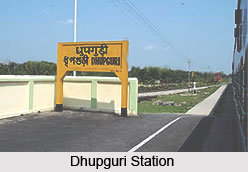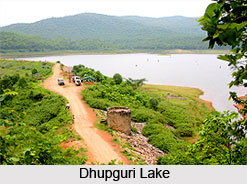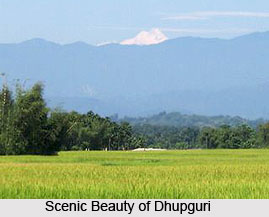 Dhupguri is a town in Jalpaiguri District. It is a taluka headquarters town in Jalpaiguri district of West Bengal.
Dhupguri is a town in Jalpaiguri District. It is a taluka headquarters town in Jalpaiguri district of West Bengal.
Location of Dhupguri
Dhupguri is surrounded by Mainaguri in the west, Goyerkata in the north, Joteswar Hat and Falakata in the east and Changrabandha in the south. Siliguri is the sub-divisional town of Darjeeling district and Jalpaiguri is the district headquarters of Jalpaiguri district. These two places are located at a distance of 80 kilometres and 30 kilometres respectively from Dhupguri.
Geography of Dhupguri
Dhupguri is located at 26.60 degree North to 89.02 degree East. It has an average elevation of 80 metres (262 feet). It is a municipal town of the Jalpaiguri district. It is located along the foothill regions of Bhutense Himalayas. Jaldhaka River is the main river flowing along the western margin of the town, besides Daina, Gilandi, Duduya, Kumlai, Jhumur and Bamni are other rivers flowing within the ambit of the town.
 Demography of Dhupguri
Demography of Dhupguri
According to the 2001 census report, Dhupguri had a population of 37,998 inhabitants where males constitute 53% and females 47% of the population. In Dhupguri, 12% of the population is les than six years of age. Dhupguri has an average literacy rate of 73%, which is higher than the national average literacy rate of 59.5%. The male literacy rate is 78% and, female literacy rate is 67%.
Economy of Dhupguri
The main occupation of the people of Dhupguri is agriculture. Dhupguri is famous for its potato cultivation which is exported to Bangladesh, Nepal and Bhutan. The paddy, jute, betel nut and vegetables are also produced in large quantities. Other than agriculture, small scale industries are also developing in this small township of Dhupguri.
Tourism of Dhupguri
 Some of the prominent tourist spots are Jalpesh Shiva Temple, Lataguri, Birpara and Madarihat. Other than these, Dhupguri Lake is also one of the important tourist destinations in Dhupguri. It is also a weekend getaway for the travellers. Sonakhali Forest, Gorumara National Park and Jaldapara National Park and Mayer Sthan are also the tourist"s hotspots.
Some of the prominent tourist spots are Jalpesh Shiva Temple, Lataguri, Birpara and Madarihat. Other than these, Dhupguri Lake is also one of the important tourist destinations in Dhupguri. It is also a weekend getaway for the travellers. Sonakhali Forest, Gorumara National Park and Jaldapara National Park and Mayer Sthan are also the tourist"s hotspots.
Visiting Information
Dhupguri is easily connected with the roadways, railways and airways. The nearest airport is the Civil Enclave Bagdogra and Coochbehar Airport and the nearest railway station is the Dhupguri Railway station. NH 31 runs across the middle of the city and state highways connecting Siliguri and Coochbehar that also passes through Dhupguri.



















